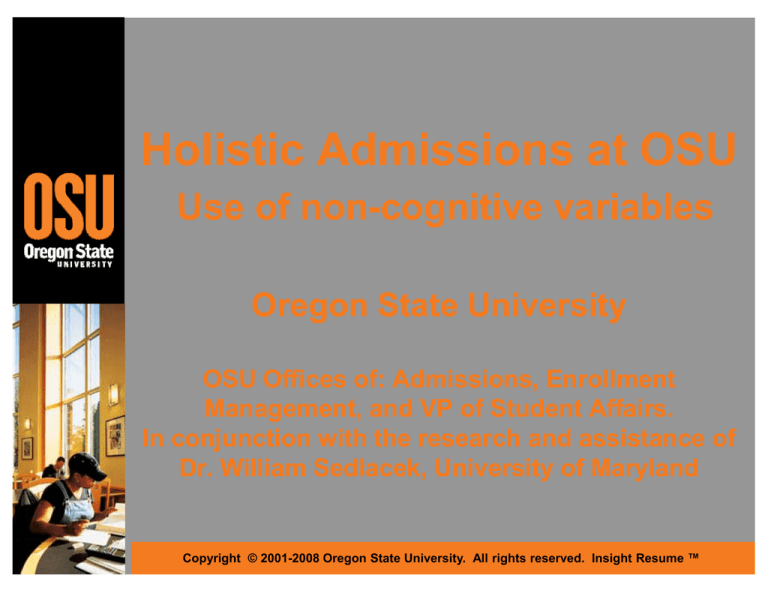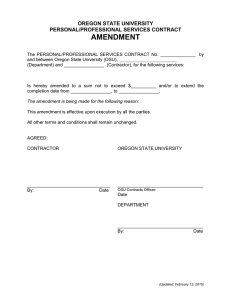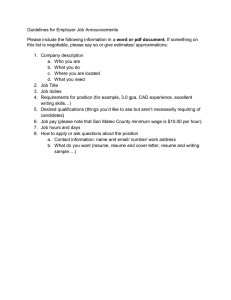
Holistic Admissions at OSU
Use of non
non--cognitive variables
O
Oregon
State
St t University
U i
it
OSU Offices of: Admissions, Enrollment
Management, and VP of Student Affairs.
In conjunction with the research and assistance of
Dr. William Sedlacek, University of Maryland
Copyright © 2001-2008 Oregon State University. All rights reserved. Insight Resume ™
Why consider noncognitive
assessment?
• Enrollment growth → selective admissions
• Affirmative action challenges
• Limitations of traditional admission criteria
Sternberg three types of intelligence
Componential ~ Ability to interpret information hierarchically in a
well defined and unchanging context. Standardized tests measure.
Experiential ~ Ability to interpret information in changing contexts,
be creative. Standardized tests DO NOT measure.
Contextual ~ Ability to adapt to a changing environment, ability to
handle & negotiate the system. Standardized tests DO NOT
measure.
• Data for Oregon State Students
Copyright © 2001-2008 Oregon State University. All rights reserved. Insight Resume ™
College Board*
Board* / OSU Data
(Correlation with 1st Yr OSU GPA; R
R--Squared Values)
AfAm
APA
Hisp
NatAm
Cauc
Total
HS
GPA
0.08
0.12
0.14
0.28
0.12
0.15
0.18
0.38
0.14
0.29
0.15
0.28
SAT
0.09
0.04
0.15
0.23
0.07
0.004
0.12
0.17
0.10
0.15
0.13
0.14
GPA+
SAT
0.14
0.15
0.23
0.37
0.19
0.17
0.30
0.46
0.20
0.33
0.23
0.31
* Answers in the Toolbox, 1985
Copyright © 2001-2008 Oregon State University. All rights reserved. Insight Resume ™
Applications
•
Admissions
- Casta
Castañ
ñeda v. U Cal
- Raised the question of non
non--cognitive variables as an
alternative approach.
- Farmer v. Ramsay
- Court ruled in favor of allowing Univ. of Maryland to use
non--cognitive variables in admitting students to medical
non
school. Plaintiff is appealing judgement
judgement..
- Grutter (Law) & Gratz (UG) casescases- U Michigan
- Court ruled against undergraduate school, for Law
school. UG assigned 20 pts/1/5 of guaranteed decision,
Law School used more of a holistic approach
- Diversity in admissions is a compelling interest for
admissions, it’s how you assess it.
John Fry, US Office of Civil Rights, has defined OSU’s
Holistic review as a national “best practice”.
•
Copyright © 2001-2008 Oregon State University. All rights reserved. Insight Resume ™
Insight Resume
OSU’s six questions ~ encompass the eight
non--cognitive variables by Sedlacek.
non
• Sedlacek NonNon-Cog:
OSU’s IR:
•
Self
Self--Concept
1) Leadership/group contributions
•
Realistic SelfSelf-Appraisal
2) Knowledge in a field/creativity
•
Handling the system/racism
3) Dealing with Adversity
•
L
Long
R
Range G
Goals
l
4) C
Community
it S
Service
i
•
Leadership
5) Handling Systemic Challenges
•
Strong Support Person
6) Goals/Task Commitment
•
Community
•
Non
Non--Traditional Learning
Copyright © 2001-2008 Oregon State University. All rights reserved. Insight Resume ™
IR Readers
• All Volunteers
– Tell them the time commitment
– Major stakeholder groups
• Diverse pool of readers
• Training Required
–
–
–
–
–
IR Training
Cultural Competency Training required
Attend Quarterly Feedback Forums required
Part of list serve of readers
Owning up to bias, opt out ~ “fairness”
Copyright © 2001-2008 Oregon State University. All rights reserved. Insight Resume ™
Answers
•
•
•
Element of “over time”
Dealing with the disclosures by students
Read by two different readers, blind read
– Can bring in a bias by name, or other file factors
– Less than 10% annual go to third read, 4 pt diff.
•
•
•
•
•
Entire IR read first, holistically, then award score for
variable no matter where it appears in the IR
Looking for active role, reflection
One or two personal examples in detail
Authenticity question
Limit of 100 words per question
– Avoids rambling
– Ease of processing
– Some of the best answers less than 100 words
•
Looking for the “Ah-Ha!” experience, a growth, learning
– Not a “list” of examples or experiences ~ it doesn’t tell you
what they learned or how they grew from the experience
Copyright © 2001-2008 Oregon State University. All rights reserved. Insight Resume ™
RESULTS: ADMISSIONS
The Insight Resume score is a good predictor of success at OSU
for applicants whose high school GPAs are less than 3.25.
Predictive Power of IR Score (High School GPA < 3.25)
2.6
OSU GPA after Firrst Year
2.55
2.5
2.45
2.4
2.35
2.3
2.25
2.2
2.15
6.0-9.9
10.0-14.9
15.0-18.0
Insight Resume Score
Copyright © 2001-2008 Oregon State University. All rights reserved. Insight Resume ™
RESULTS: RETENTION
The Insight Resume is a good predictor of the number of first-year
students who return to OSU for their sophomore year.
Retention by IR Score
First-year Reten
ntion
95.00%
90.00%
85.00%
80.00%
75.00%
6.0-9.9
10.0-14.9
15.0-18.0
Insight Resume Score
Copyright © 2001-2008 Oregon State University. All rights reserved. Insight Resume ™
RESULTS: OSU Appeals Committee
Use of the Insight Resume has helped the Undergraduate Admissions Committee make
better decisions about which students to admit to OSU. The number of students
returning for their sophomore year is increasing.
YEAR
Before/After IR
Success Rate
2003-04
Before
63%
2004-05
After
70%
2005-06
After
85%
With
Wi
h access to IInsight
i h R
Resume scores, the
h U
Undergraduate
d
d
Ad
Admissions
i i
C
Committee
i
iis
making better decisions about which students to admit. It is interesting to note that if
you look at the students the UAC is admitting, the percentage of them that are
students of color is increasing.
Year
Before/After IR
Students of Color
2003-04
Before
22%
2004-05
After
23%
2005-06
After
31%
Copyright © 2001-2008 Oregon State University. All rights reserved. Insight Resume ™
NON-COGNITIVE MODEL
& OSU’s IR Impact Nationally
Schools trained and/or currently
using OSU’s IR:
Schools who consulted with/or visited
OSU regarding IR:
Washington State University Pullman
Washington
g
State University
y Vancouver
Univ. British Columbia Business School
University of Central Missouri
DePaul University
Eastern Washington University
Linn--Benton Community College
Linn
Central Oregon Community College
Colorado State University
Manchester College
Linfield College
University of Nevada Las Vegas
University of Michigan
University
y of Minnesota
Harvard Law School
UCLA
University of Kansas
University of Missouri
Purdue University
Washington DC Scholars Foundation
Chicago Scholarship Commission
Kentucky Higher Educ. Review Board
Copyright © 2001-2008 Oregon State University. All rights reserved. Insight Resume ™
Thank you!
Michele Sandlin
michele.sandlin@oregonstate.edu
William E. Sedlacek
wsed@umd.edu
www.umd.edu/Diversity/General/Reading/Sedlacek
Resources
•
Sedlacek, W. E. (2004). Beyond the big test: Noncognitive
assessment in higher education.
education. San Francisco: Jossey
Jossey--Bass.
To purchase: http://www.josseybass.com/WileyCDA/
http://www josseybass com/WileyCDA/
•
Sedlacek, W. E. (in press). The case for noncognitive measures.
measures. In
W. Camara and E. Kimmel (Eds.). Choosing students: Higher
education admission tools for the 21st century.
century. Mahwah, NJ:
Lawrence Erlbaum.
•
A comprehensive list of Dr. Sedlacek’s publications may be found at:
http://www.umd.edu/Diversity/General/Reading/Sedlacek
•
Information on OSU’s process may be found at:
http://oregonstate.edu/admissions/2004req/2004profile.html
Copyright © 2001-2008 Oregon State University. All rights reserved. Insight Resume ™



